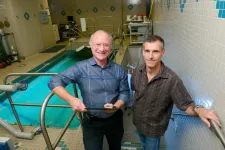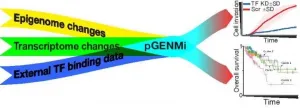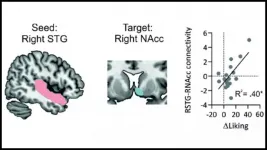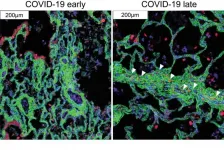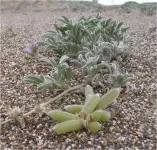(Press-News.org) DALLAS - March. 29, 2021 - With NASA preparing to send humans to Mars in the 2030s, researchers are studying the physical effects of spending long periods in space. Now a new study by scientists at UT Southwestern shows that the heart of an astronaut who spent nearly a year aboard the International Space Station shrank, even with regular exercise, although it continued to function well.
The results were comparable with what the researchers found in a long-distance swimmer who spent nearly half a year trying to cross the Pacific Ocean.
The study, published today in Circulation, reports that astronaut Scott Kelly, now retired, lost an average of 0.74 grams - about three-tenths of an ounce - per week in the mass of his heart's left ventricle during the 340 days he spent in space, from March 27, 2015, to March 1, 2016. This occurred despite a weekly exercise regimen of six days of cycling, treadmill, or resistance work.
Despite the shrinkage, which was accompanied by an initial drop in the left ventricle's diameter when relaxed to fill with blood (diastolic diameter), the astronaut's heart adapted relatively well, according to senior author END
Even with regular exercise, astronaut's heart left smaller after a year in space
2021-03-29
ELSE PRESS RELEASES FROM THIS DATE:
New computational models to understand colon cancer
2021-03-29
Although the development of secondary cancerous growths, called metastasis, is the primary cause of death in most cancers, the cellular changes that drive it are poorly understood. In a new study, published in Genome Biology, researchers at the University of Illinois Urbana-Champaign have developed a new modeling approach to better understand how tumors become aggressive.
"Researchers have identified several cellular pathways that change when a tumor becomes aggressive. However, it is difficult to understand how they affect the tumor," said Steven Offer, an assistant professor of molecular pharmacology and experimental therapeutics at Mayo Clinic, Minnesota. "We wanted to develop a simple system that can model how cancer cells form ...
Percutaneous image guided thermal ablation safe, effective therapy for metastatic gynecologic cancers
2021-03-29
FINDINGS
A new study by researchers at the UCLA Jonsson Comprehensive Cancer Center found using percutaneous image guided needle based thermal ablation -- the precise application of extreme heat or cold to a tumor using sophisticated ultrasound, CT or MRI in a single outpatient session -- is a safe and effective adjunctive therapy for the local control of metastatic gynecologic cancers throughout lungs, liver, soft tissues in the abdomen and pelvis and bones in patients with advanced localized cancers unresponsive to systemic therapy.
Nearly 96% of the patients in the study achieved a complete tumor response over a median follow up period of 10 months. The overall survival rate was 37.5 months and the progression-free ...
Racial disparities in chronic disease death rates persist despite efforts to close gap
2021-03-29
BOSTON - In the last 20 years, Black adults living in rural areas of the United States have experienced high mortality rates due to diabetes, high blood pressure, heart disease and stroke compared to white adults. In a research letter written by colleagues at Beth Israel Deaconess Medical Center (BIDMC) and published in the END ...
Lab model offers hope for macular degeneration patients
2021-03-29
Age-related macular degeneration (AMD), which leads to a loss of central vision, is the most frequent cause of blindness in adults 50 years of age or older, affecting an estimated 196 million people worldwide. There is no cure, though treatment can slow the onset and preserve some vision.
Recently, however, researchers at the University of Rochester have made an important breakthrough in the quest for an AMD cure. Their first three-dimensional (3D) lab model mimics the part of the human retina affected in macular degeneration.
Their model combines stem cell-derived ...
Why the brain enjoys music
2021-03-29
Communication between the brain's auditory and reward circuits is the reason why humans find music rewarding, according to new research published in JNeurosci.
Despite no obvious biological benefits, humans love music. Neuroimaging studies highlight similarities between how the brain's reward circuits process music and other rewards like food, money, and alcohol. Yet neuroimaging studies are correlational by nature. In a new study, Mas-Herrero et al. sought to nail down the causal role of this circuitry by using non-invasive brain stimulation.
A group of pop music fans listened ...
New technique provides detailed map of lung pathology in COVID-19
2021-03-29
A team led by investigators at Weill Cornell Medicine and NewYork-Presbyterian has used advanced technology and analytics to map, at single-cell resolution, the cellular landscape of diseased lung tissue in severe COVID-19 and other infectious lung diseases.
In the study, published online March 29 in Nature, the researchers imaged autopsied lung tissue in a way that simultaneously highlighted dozens of molecular markers on cells. Analyzing these data using novel analytical tools revealed new insights into the causes of damage in these lung illnesses and a rich data resource for further research.
"COVID-19 is a complex disease, and we still don't understand exactly what it does to a lot of organs, but with this study we were able to develop ...
Brazilian researchers obtain more efficient red bioluminescence
2021-03-29
Researchers at the Federal University of São Carlos (UFSCar) in the state of São Paulo, Brazil, have developed a novel far red light-emitting luciferin-luciferase system that is more efficient than those available commercially. An article on the subject is published in the International Journal of Molecular Sciences.
The study was supported by São Paulo Research Foundation - FAPESP via the Thematic Project "Arthropod bioluminescence: biological diversity in Brazilian biomes, biochemical origin, structural/functional evolution of luciferases, molecular differentiation of lanterns, biotechnological, environmental and educational applications", for which the principal ...
Remote-friendly student project presentations enable creativity and risk-taking
2021-03-29
ANN ARBOR--In a two-year study that could help guide educators developing the post-pandemic new normal, student groups at the University of Michigan assigned to make video presentations showed more creativity and risk-taking than groups making conventional in-person presentations.
"Given the importance of project-based learning, our study provides a way to turn virtual limitations into an advantage," said Fei Wen, U-M associate professor of chemical engineering. "We can enhance the student experience and learning outcomes."
Higher education, along with society at large, anticipates a shift in the balance between ...
Common medications contain animal byproducts, study finds
2021-03-29
More physicians and pharmacists are advocating for patients to be made aware of animal byproducts contained in common medications, according to new research in the Journal of Osteopathic Medicine. Common medications, including widely used blood thinners and hormones, are often derived from animal byproducts and prescribed without consulting the patient about their beliefs.
"Patients deserve to know what their medications are made of, yet this information is rarely shared," said Sara Reed, student doctor at Lincoln Memorial University (LMU) DeBusk ...
Coastal lupine faces specific extinction threat from climate change
2021-03-29
Climate change is altering the world we share with all living things. But it's surprisingly difficult to single out climate change as an extinction threat for any one particular species protected under the Endangered Species Act.
To date, the U.S. Fish and Wildlife Service has only formally considered impacts from climate change in listing actions for four animal species and one alpine tree.
But the effects of climate change extend to temperate climates as well. A new analysis of population data published in the journal Ecosphere shows that climate change represents a specific extinction threat for an endangered coastal lupine plant.
Biologists including Eleanor Pardini at Washington University in St. Louis have tracked all of the known stands ...
